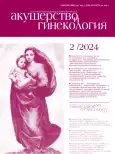Chorioamnionitis: diagnosis and role in complications during pregnancy and fetal development
- Authors: Shchegolev A.I.1, Tumanova U.N.1, Serov V.N.1
-
Affiliations:
- Academician V.I. Kulakov National Medical Research Centre for Obstetrics, Gynecology and Perinatology, Ministry of Health of Russia
- Issue: No 2 (2024)
- Pages: 5-14
- Section: Reviews
- Published: 29.02.2024
- URL: https://journals.eco-vector.com/0300-9092/article/view/631344
- DOI: https://doi.org/10.18565/aig.2024.10
- ID: 631344
Cite item
Abstract
The article presents an analysis of the literature data on the diagnosis of chorioamnionitis and its role in the complications during pregnancy and fetal development. Currently there are several terms referring to inflammation of the amniotic cavity and membranes: clinical chorioamnionitis, histological (subclinical) chorioamnionitis and Triple I (intrauterine inflammation or infection or both); the criteria for their diagnosis are given as well. The literature data indicate that clinical and laboratory manifestations of the disease are not always accompanied by morphological detection of inflammatory neutrophil infiltration of tissues and positive microbiological studies. Amniotic fluid infection including chorioamnionitis has been noted to be either an initiating event or a common final pathway resulting in childbirth in more than a third of such patients. The detection rate of chorioamnionitis is inversely proportional to the duration of pregnancy. Chorioamnionitis is associated with an increased risk of developing various maternal infectious complications, including bacteremia, endometritis, septic thromboembolism, pelvic abscess and sepsis, uterine atony and postpartum bleeding. Adverse neonatal outcomes include fetal inflammatory response syndrome, neonatal sepsis, bronchopulmonary dysplasia, intraventricular hemorrhage, periventricular leukomalacia, cerebral palsy, necrotizing enterocolitis.
Conclusion: Chorioamnionitis remains the main cause of premature birth, maternal and neonatal morbidity. The available up-to-date findings on the links in the pathogenesis of chorioamnionitis should become the basis for the development of methods for its prevention, diagnosis and treatment, as well as management of pregnancy and childbirth.
Full Text
About the authors
Alexander I. Shchegolev
Academician V.I. Kulakov National Medical Research Centre for Obstetrics, Gynecology and Perinatology, Ministry of Health of Russia
Author for correspondence.
Email: ashegolev@oparina4.ru
ORCID iD: 0000-0002-2111-1530
Dr.Med. Sci., Professor, Head of the 2nd Pathology Department
Russian Federation, 117997, Moscow, Ac. Oparina str., 4Uliana N. Tumanova
Academician V.I. Kulakov National Medical Research Centre for Obstetrics, Gynecology and Perinatology, Ministry of Health of Russia
Email: u.n.tumanova@yandex.ru
ORCID iD: 0000-0002-0924-6555
Dr.Med. Sci., Leading Researcher of the 2nd Pathology Department
Russian Federation, 117997, Moscow, Ac. Oparina str., 4Vladimir N. Serov
Academician V.I. Kulakov National Medical Research Centre for Obstetrics, Gynecology and Perinatology, Ministry of Health of Russia
Email: ashegolev@oparina4.ru
Academician of the Russian Academy of Sciences, Dr.Med. Sci., Professor, President of the Russian Society of Obstetricians and Gynaecologists
Russian Federation, 117997, Москва, ул. Академика Опарина, д. 4References
Supplementary files









